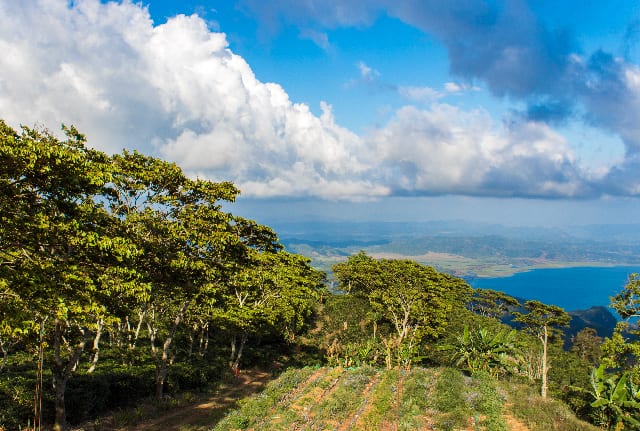[coffee planting] how should coffee producers deal with unexpected weather conditions?
Professional coffee knowledge exchange More coffee bean information Please pay attention to coffee workshop (Weixin Official Accounts cafe_style)
In early July, Brazil's coffee-producing regions suffered a frost. Coffee crops are being harvested, but weather conditions are expected to have some impact on next year's production. When frost strikes, you can do little to protect your crops. But there are ways to deal with other unexpected weather conditions.

The impact of unexpected weather conditions
Keith Pech is the sales and export manager of Damarli Estate, the Boqui specialty area of Panama. He told me that the ideal weather conditions there are "sunny and sunny, with rain from April to November and dry season from December to March". Rose summer is a popular variety of coffee in this area.
Keith told me that he often encountered unexpected weather conditions, and the most damaging was "the brief arrival of Rain Water after the dry season and harvest, resulting in flowering and loss of fruit in trees." Rain Water will make the fruit absorb water, which will make the coffee cherries heavier and then fall, he said. "the end result is a decrease in coffee production, and if growers sell at normal market prices, they will suffer heavy losses."
He also highlighted the increased risk of diseases and insect pests in unexpected weather conditions, adding that "if the weather switches between rainy and dry, roya [coffee leaf rust] will become a huge problem."
Francisco Guimar ã es produces coffee in Fazenda Lavrinha, in the Brazilian state of Minas Gerais. "one of the most critical factors related to weather conditions is the high temperature during flowering or fruit development of coffee, especially when these high temperatures are combined with low soil moisture, resulting in a serious water shortage crisis," he told me. "
"when these conditions occur during flowering, the risk of miscarriage increases greatly and the number of fruits decreases, resulting in a decrease in overall productivity. If this happens during the fruit growing period, it will affect the weight gain and product quality of the fruit. This may lead to smaller fruit and lower market value, "he said."
Francisco told me that in addition to high temperatures and lack of water, his crops could also be damaged by other weather events. "there is a risk of hail in this area, which may cause serious crop losses, such as fallen leaves and fruits," he said. "
Like Keith, he mentioned the increased risk of diseases and pests caused by abnormal weather conditions, telling me that because hail can damage plants, it makes bacterial diseases more susceptible to infection.
"recently, we lost about 2000 bags of coffee due to damage to coffee crops caused by a hailstorm," he said. "in winter, frosts can occur and, in the most extreme cases, damage entire crops. In this case, pruning is necessary and production can be completely stopped. "
Unexpected weather events not only affect crops in the field. Even after harvest, coffee quality is at risk if there are showers or temperature changes. Coffee cherries dried on the terrace can ferment fungal infections during unpredictable rains or cold periods.
Bruno Ribeiro is a coffee quality consultant responsible for the quality of post-harvest coffee. "the coffee farm of the producer is open-air," he said. Therefore, accidents are always inevitable. Producers and their partners should seek production techniques that minimize the risk of loss of coffee quality. "
Deal with unexpected weather conditions
So what can you do to reduce the risk of damage and quality degradation?
Prepare for the rainy day
If you have an established farm, it is unrealistic to transfer your crops. But if you want to build a new plantation, be sure to consider the land conditions. Avoid low-lying areas where water accumulates during heavy rains. These zones increase the risk of pests, root rot and fungal infections.
You should also consider planting big trees around crops as a windshield. This protects coffee during storms and also prevents the spread of coffee leaf rust.
Bruno says the weather should be observed by regularly surfing the Internet or watching TV forecasts. If you know that an unusual weather event is coming, you can be better prepared.
He also said it was important to have the right tools and materials on hand, and suggested that you should have "harvest cloth and tarpaulins for covering your property (coffee)" as well as disinfectants for coffee.
How to deal with rainstorm
Too much groundwater can cause root rot and put plants at risk of fungi and bacteria. If it is unusually wet, check for stagnant water around the trees and create irrigation channels if necessary.
If it rains during the harvest, the cherries are in danger of expanding and falling to the ground. Pay close attention to the weather forecast and try to arrange extra pickers to harvest in advance if necessary.
If possible, build a drying terrace on the slope-so that if you do encounter unexpected rain, at least the coffee will not be soaked in the water. A retractable roof or mulch is a good way to further reduce Rain Water's erosion. If the budget is exceeded, tarpaulins will also work.
However, coffee covered under the mulch still carries some risks. "if the rainfall time is prolonged, depending on the treatment process used after harvest, there may still be a quality loss in this batch," Bruno said. "
Francisco told me that when sporadic rain occurs, his farm uses a mechanical dryer. This is an investment, but it can speed up drying and even reduce crop losses during unexpected rainy seasons.
Keith suggests that if all methods fail, you can consider transferring crops. He said, "I know a farmer who has a big Rain Water problem in his belt. If he relies on his own conditions, he can't dry the coffee." But one of his friends had a free terrace that didn't rain. He moved the coffee there to dry and succeeded in saving his crop! "
How to deal with drought
Water is a key element in any farm. If there is not enough water, coffee plants will not bear fruit. Keith told me that if there is not enough rain during planting, the young trees will die. If the dry period lasts too long after flowering, the tree will lose its branches and leaves, resulting in crop failure. He said that Rain Water is very important in the fruit formation stage.
Irrigation systems are an effective way to ensure that all crops get enough water. "Fazenda Lavrinha has four drip irrigation systems in coffee crops," Francisco said. These systems are efficient and combined with management plans to achieve sustainable high productivity and optimize water and energy resources.
He told me that through a climate monitoring system, he knew that there were two rains in August, when the coffee had already blossomed. "then as the temperature rose, there was no rain for 37 days. This is a very critical period for coffee, in which case the use of irrigation management systems is essential to avoid a decline in production. "
You may not be able to afford a complete drip irrigation system and climate monitoring, but surface irrigation may be cheaper. You can also set up storage tanks throughout the farm to collect Rain Water for use during drought.
If your crop is affected by unexpected weather, it may cause stress and low morale. In this era of climate change, you sometimes have to deal with sudden weather conditions. But there are always ways to reduce the impact.
"be creative, know what problems bad weather can cause, and make plans A, B and C," Keith said. Make more friends and don't isolate yourself. "
Bruno told me, "Coffee cherries are metabolically active fruits, post-harvest treatment, fruit moisture, maturity, drying temperature [all affected by the weather]." You can only do your best and listen to your destiny. "
Translated from Perfect Daily Grind
Written by KJ Yeung
END
Important Notice :
前街咖啡 FrontStreet Coffee has moved to new addredd:
FrontStreet Coffee Address: 315,Donghua East Road,GuangZhou
Tel:020 38364473
- Prev

How do you get the flavor of coffee? Does the water quality of brewing coffee have any effect on coffee?
Professional coffee knowledge exchange more coffee bean information Please pay attention to the coffee workshop (Wechat official account cafe_style) which factors determine the flavor? People should be very vague about the word flavor. What on earth is good coffee? To put it more simply, who has the final say that coffee tastes good? I actually think the answer is "it's up to you" and "it's up to everyone."
- Next

The English name of Piccolo Piccolo Coffee is derived from the meaning Piccolo Latte O Ruibai Coffee which is strong and tastes better
Professional coffee knowledge exchange more coffee bean information please follow the coffee workshop (Wechat official account cafe_style) do you know, if we use all the coffee shop menus around the world to do "word frequency analysis" the frequency of certain ── words appear in specific articles, "latte", "cappuccino", "Mo"
Related
- Beginners will see the "Coffee pull flower" guide!
- What is the difference between ice blog purified milk and ordinary milk coffee?
- Why is the Philippines the largest producer of crops in Liberia?
- For coffee extraction, should the fine powder be retained?
- How does extracted espresso fill pressed powder? How much strength does it take to press the powder?
- How to make jasmine cold extract coffee? Is the jasmine + latte good?
- Will this little toy really make the coffee taste better? How does Lily Drip affect coffee extraction?
- Will the action of slapping the filter cup also affect coffee extraction?
- What's the difference between powder-to-water ratio and powder-to-liquid ratio?
- What is the Ethiopian local species? What does it have to do with Heirloom native species?

